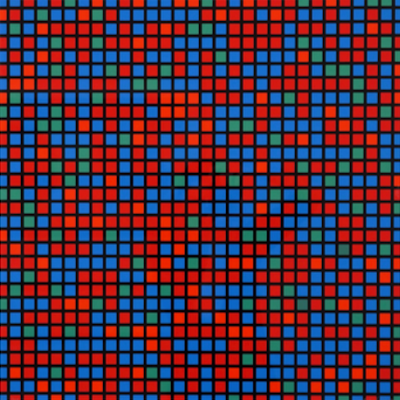
Details
Artist
Styles
From the Haggadah of Passover, 1985 - Published by Capepark LTD., London - Printed by Aterlier Arcay in Paris // Yaacov Agam's Haggadah – Hakerara (The Seder Plate) (1985) is a silkscreen print that forms part of his exploration of Jewish tradition through a modern, geometric lens. This piece, a limited edition from his Haggadah of Passover series, presents a vibrant and abstract interpretation of the traditional Seder plate. The artwork features six colorful circles arranged in a circular formation, each labeled in Hebrew to represent the symbolic foods used during the Passover Seder. The bright colors—yellow, orange, green, purple, and blue—are framed by a golden border, all set against a patterned brown background with interconnected dots and lines. The dynamic arrangement captures Agam’s signature style, emphasizing movement and spiritual connection. Printed by Atelier Arcay in Paris and published by Capepark LTD., this work merges tradition with contemporary abstraction, inviting reflection on cultural and spiritual heritage.
Haggadah – Hakerara (The Seder Plate), 1985
form
Medium
Size
34.3 x 34.3 cm
- Inches
- Centimeters
Edition
Price
- USD
- EUR
- GBP
Details
Artist
Styles
From the Haggadah of Passover, 1985 - Published by Capepark LTD., London - Printed by Aterlier Arcay in Paris // Yaacov Agam's Haggadah – Hakerara (The Seder Plate) (1985) is a silkscreen print that forms part of his exploration of Jewish tradition through a modern, geometric lens. This piece, a limited edition from his Haggadah of Passover series, presents a vibrant and abstract interpretation of the traditional Seder plate. The artwork features six colorful circles arranged in a circular formation, each labeled in Hebrew to represent the symbolic foods used during the Passover Seder. The bright colors—yellow, orange, green, purple, and blue—are framed by a golden border, all set against a patterned brown background with interconnected dots and lines. The dynamic arrangement captures Agam’s signature style, emphasizing movement and spiritual connection. Printed by Atelier Arcay in Paris and published by Capepark LTD., this work merges tradition with contemporary abstraction, inviting reflection on cultural and spiritual heritage.
- Recently Added
- Price (low-high )
- Price (high-low )
- Year (low-high )
- Year (high-low )
Yaacov Agam
Yellow Haze, From The Evolution Suite I, C. 1995
Limited Edition Print
Mixed Media
EUR 2,400
Yaacov Agam
Haggadah – Le Shana Haba’Ah (Next Year In Jerusalem), 1985
Limited Edition Print
Silkscreen
USD 450
Yaacov Agam
Haggadah – Had Gadya #3 (The Little Lamb), 1985
Limited Edition Print
Silkscreen
USD 450
Yaacov Agam
Haggadah – Had Gadya #2 (The Little Lamb), 1985
Limited Edition Print
Silkscreen
USD 450
Yaacov Agam
Haggadah – Had Gadya #1 (The Little Lamb), 1985
Limited Edition Print
Silkscreen
USD 450
What is geometric abstract art?
Geometric abstraction is a form of abstract art that uses geometric shapes arranged in a non-illusionistic space (though not always) and combined into non-representational (non-objective) compositions. Based on years of artistic research, some artists have proposed that geometric abstraction offers a solution to modern challenges by rejecting traditional illusionistic practices in favor of clarity and simplicity.





















































